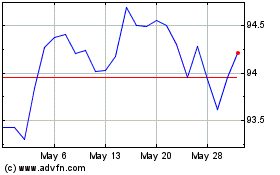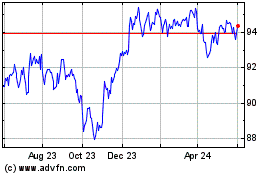3 Reasons to Consider the Crossover Bond ETF - ETF News And Commentary
November 15 2012 - 6:35AM
Zacks
In the past few quarters, the markets have witnessed speculation
about a number of events and their impact on the markets as we head
into 2013. ECB’s policy in order to tame the Euro zone crisis,
Fed’s implementation of QE3 and the impact of the presidential
election are all weighing on the markets as they struggle to find
their footing.
This global economic uncertainty coupled with a slowdown in the
domestic U.S. growth rate have for long led to a risk aversion
climate among investors and an expansionary monetary policy by the
Fed—both leading to a frustratingly low interest rate scenario in
the economy(read Inside The Two ETFs Up More Than 140% YTD).
On the other side of the ledger are the income-seeking investors
who have had to comply with ultra low yields for quite some time
now. While most of the high yielding sources from the ETF space
seems to be tapped out, there is one segment which has been pretty
much overlooked although it looks promising, ‘crossover bonds’
(read 3 Excellent ETFs with More than 4% Yield).
The SPDR BofA Merrill Lynch Crossover Corporate Bond ETF
(XOVR) is one such fund
that targets this corner of the U.S. bond market. Bonds in this
fund are basically fixed income securities that are highly rated in
the non-investment grade bond space or they are lower rated in the
investment grade bond space (see Market Vectors Files for
Innovative Bond ETF).
Launched in June of 2012, XOVR has been able to amass just about
$13 million till date and does a daily volume of just around 11,000
shares. This suggests that the product has been highly ignored by
the investors. However, below are three reasons that one may want
to consider giving this overlooked product a chance in their
portfolio:
1) Providing Parity in Risk-Return Tradeoff
Traditionally, high quality bond ETFs are associated with lower
yields and low quality (Junk) ones with higher yields. This is due
to the default (counterparty) risk premium that the investor takes
before investing in the lower rated (i.e. Junk) bond ETFs.
Investing in these two classes of ETFs require different types
of risk appetite and the risk-return tradeoff is demonstrated by 1)
high yields— high probability of default and 2) low yields—low
probability of default.
However, the crossover bond ETF XOVR, provides parity in the
risk-return tradeoff and captures the shades of grey between these
two scenarios. Thus they provide the opportunity for 1) higher
current income —as opposed to investment grade bond ETFs by taking
on 2) relatively lesser default risk —as opposed to non-investment
grade bond ETFs (see Forget China, Buy These Emerging Market ETFs
Instead).
XOVR has a 30 day SEC Yield of 3.40% and a majority of its
assets are allocated to investment grade securities, i.e. 55.16% of
its total assets are ‘Baa’ rated which is the
lowest rating among investment grade bonds.
2) Pricing Differentials During Bond Crossover can be
Advantageous
Among all fixed income securities, Crossover Bonds are the most
susceptible to being upgraded to investment grade or downgraded to
Junk due to their proximity to either rating. However, the rating
would depend on individual credit rating agencies.
Nevertheless, when a bond is downgraded to junk from investment
grade by one agency, the implied yield rises and the bond price
falls. This indicates an entry point at low levels. However, it
might happen that another agency after a brief period of time might
upgrade their rating on the same bond which pushes implied yield
lower, resulting in capital appreciation (see 3 Actively Managed
Bond ETFs for Stability and Income).
On the contrary, if a junk bond is upgraded to investment grade
by a rating agency, the price of the bond increases, indicating a
decent exit point. Now if another agency downgrades it to junk
again after a period of time, the capital loss can be avoided.
3) Probability of Potentially Higher Yields at Lower
Expenses
As we have already discussed, the crossover bond ETF, XOVR,
provides the potential for high yields due to the nature of its
target securities. Furthermore it comes at a relatively lower
expense especially compared to other high yielding avenues from the
Junk Bond ETF space (read HYEM: The Best Choice in Junk Bond
ETFs?).
XOVR charges just 30 basis points in fees and expenses compared
to a Morningstar category average of 0.51%. Compared to this, JNK
charges 40 basis points in annual fees and expenses, whereas HYG
charges an expense ratio of 50 basis points.
Other Features
XOVR tracks the BofA Merrill Lynch US Diversified Crossover
Corporate Index. The components in the index are mostly U.S. Dollar
denominated, thereby eliminating any currency risk. It targets the
intermediate end on the crossover bond yield curve suggested by an
average maturity of 7.90 years. Also it carries moderate interest
rate risk and has a weighted average duration of 5.72 years (see
more in the Zacks ETF Center).
Presently, it holds 158 securities in its portfolio and has a
30-Day SEC yield of 3.40%. XOVR has returned 4.35% since its
inception, as of 7th November 2012.
|
Data Point
|
XOVR
|
|
Returns (Since Inception)
|
4.35%
|
|
Average Duration
|
5.72 years
|
|
Average Maturity
|
7.90 Years
|
|
Assets Under Management
|
$13 million
|
|
Expense Ratio
|
0.30%
|
|
Average Credit Quality of the
Index
|
BA1
|
|
Average Daily Volume
|
11,000
|
|
30 Day SEC Yield
|
3.40%
|
Want the latest recommendations from Zacks Investment Research?
Today, you can download 7 Best Stocks for the Next 30
Days. Click to get this free report >>
ISHARS-IBX HYCB (HYG): ETF Research Reports
SPDR-BC HY BD (JNK): ETF Research Reports
SPDR-BAML CR CB (XOVR): ETF Research Reports
To read this article on Zacks.com click here.
Zacks Investment Research
Want the latest recommendations from Zacks Investment Research?
Today, you can download 7 Best Stocks for the Next 30 Days. Click
to get this free report
SPDR Bloomberg High Yiel... (AMEX:JNK)
Historical Stock Chart
From Dec 2024 to Jan 2025

SPDR Bloomberg High Yiel... (AMEX:JNK)
Historical Stock Chart
From Jan 2024 to Jan 2025
